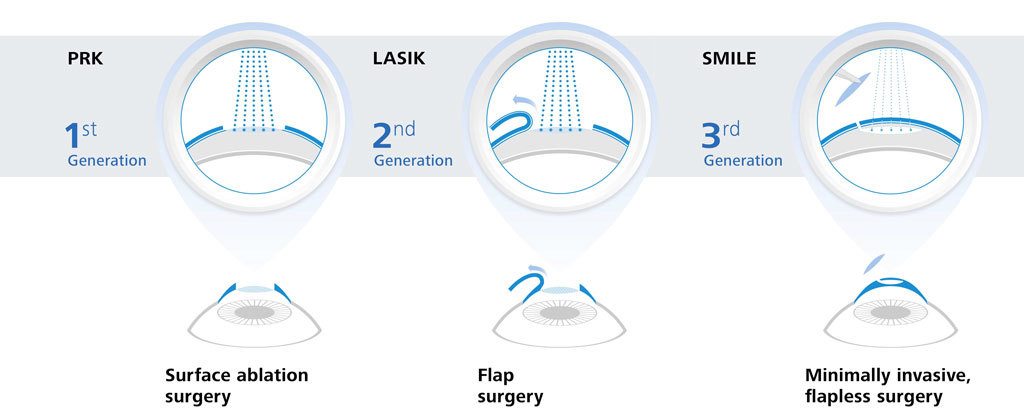Intrigued In Learning More About The Differences Between SMILE, LASIK, And PRK Eye Procedures?
Intrigued In Learning More About The Differences Between SMILE, LASIK, And PRK Eye Procedures?
Blog Article
Authored By-Ryberg Waller
If you've been considering SMILE eye surgical procedure, you might wonder just how it compares to LASIK and PRK. Each procedure has its very own set of benefits and factors to consider. From quicker healing times to prospective dangers, there are crucial differences you must understand before deciding. Recognizing these differences will certainly assist you make an informed option that straightens with your specific needs and assumptions. cataract surgery drops to understand even more regarding how these procedures contrast thoroughly? Go on exploring to get an extensive understanding of SMILE, LASIK, and PRK.
SMILE Eye Surgical Treatment Introduction
If you're thinking about SMILE eye surgical procedure, you'll discover it to be a minimally invasive treatment with a fast recovery time. During SMILE (Tiny Cut Lenticule Extraction), a laser is utilized to develop a tiny, precise incision in the cornea to remove a little piece of tissue, reshaping it to correct your vision. This varies from LASIK, where a flap is developed, and PRK, where the external layer of the cornea is completely gotten rid of.
Among the essential benefits of SMILE is its minimally intrusive nature, resulting in a faster healing procedure and much less pain post-surgery. The recovery time for SMILE is fairly quick, with lots of individuals experiencing boosted vision within a day or two. additional resources makes it a popular option for those looking for a hassle-free and reliable vision improvement treatment. Furthermore, SMILE has actually been shown to have a lower risk of completely dry eye syndrome compared to LASIK, making it a beneficial choice for individuals concerned regarding this possible negative effects.
Differences In Between SMILE, LASIK, and PRK
When comparing SMILE, LASIK, and PRK eye surgeries, it's important to understand the distinctive strategies used in each treatment for vision correction.
SMILE (Small Laceration Lenticule Removal) is a minimally intrusive procedure that involves producing a tiny cut to remove a lenticule from the cornea, reshaping it to fix vision.
LASIK (Laser-Assisted Sitting Keratomileusis) involves producing a slim flap on the cornea, using a laser to improve the underlying tissue, and then rearranging the flap.
PRK (Photorefractive Keratectomy) gets rid of the outer layer of the cornea prior to reshaping the tissue with a laser.
The major distinction depends on the way the cornea is accessed and treated. SMILE is flapless, making it an excellent alternative for individuals with thin corneas or those associated with call sports. LASIK offers quick aesthetic recovery as a result of the flap production, yet it may pose a higher threat of flap-related difficulties. PRK, although having a longer recovery period, stays clear of flap-related concerns completely.
Comprehending these variations is important in picking the most ideal procedure for your vision correction demands.
Advantages And Disadvantages Contrast
To assess the benefits and drawbacks of SMILE, LASIK, and PRK eye surgical procedures, it's necessary to consider the certain advantages and potential limitations of each procedure. SMILE surgery provides the benefit of a minimally intrusive treatment, with a smaller sized incision and possibly quicker healing time contrasted to LASIK and PRK. It additionally minimizes the risk of dry eye post-surgery, a typical adverse effects of LASIK. However, SMILE may have constraints in dealing with greater levels of myopia or astigmatism contrasted to LASIK.
LASIK surgical procedure provides quick visual healing and marginal pain throughout the treatment. It's extremely effective in dealing with a large range of refractive mistakes, consisting of nearsightedness, hyperopia, and astigmatism. Yet, LASIK brings a danger of flap problems, which can influence the corneal framework.
PRK eye surgical treatment, while not as preferred as LASIK, stays clear of producing a corneal flap, lowering the risk of flap-related problems. It appropriates for individuals with thin corneas or irregular corneal surface areas. Nevertheless, PRK has a much longer healing time and might involve much more pain throughout the recovery process.
Final thought
So, when it comes to choosing in between SMILE, LASIK, and PRK, think of it like choosing the excellent pair of footwear. SMILE resembles a sleek, comfortable pair of sneakers - fast and very easy.
LASIK is more like trendy high heels - flashy and fast, but with some possible risks.
PRK is like durable hiking boots - trustworthy and resilient, but calling for a little bit even more time and effort.
Ultimately, the very best choice depends on your specific demands and choices.
